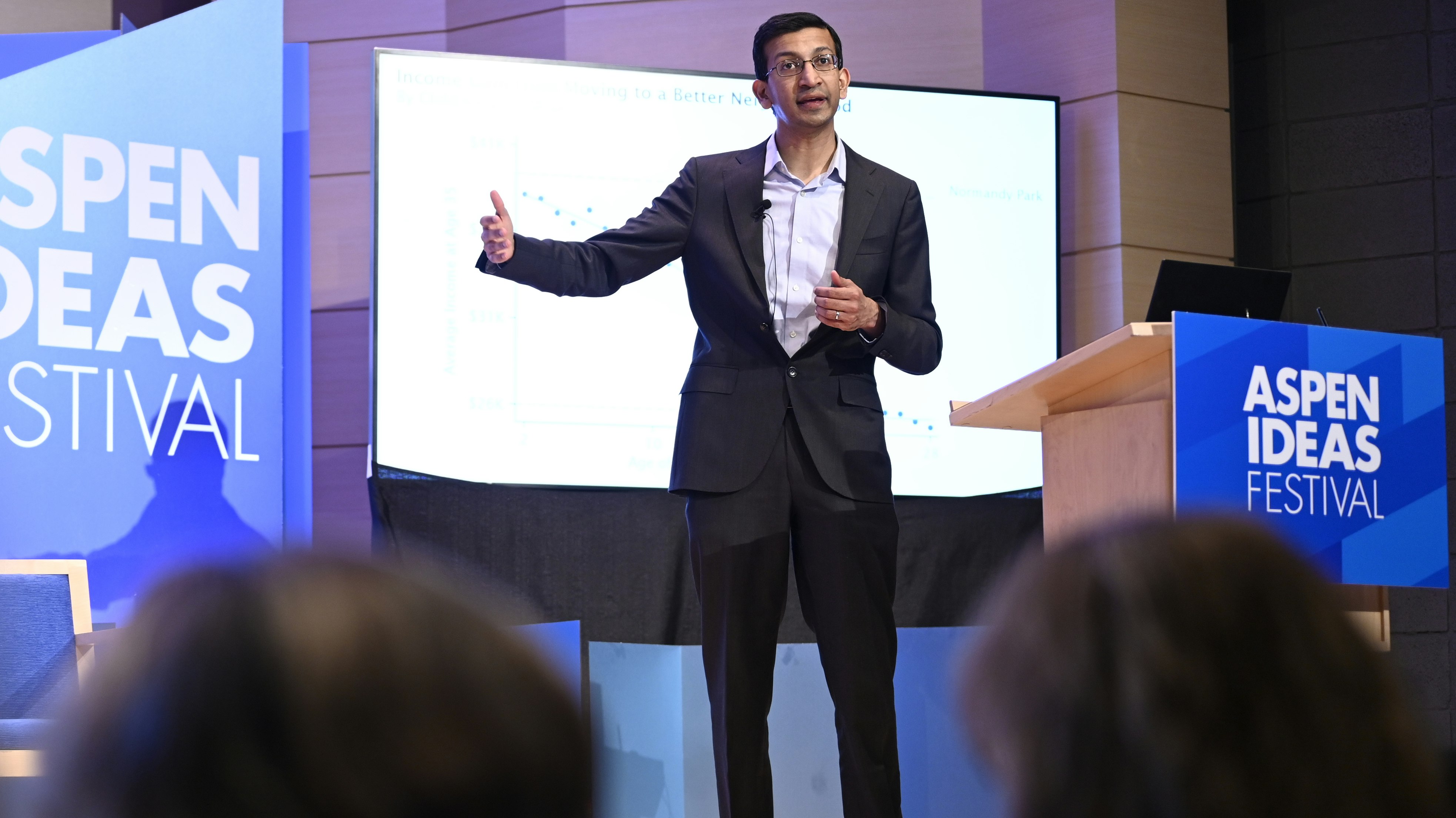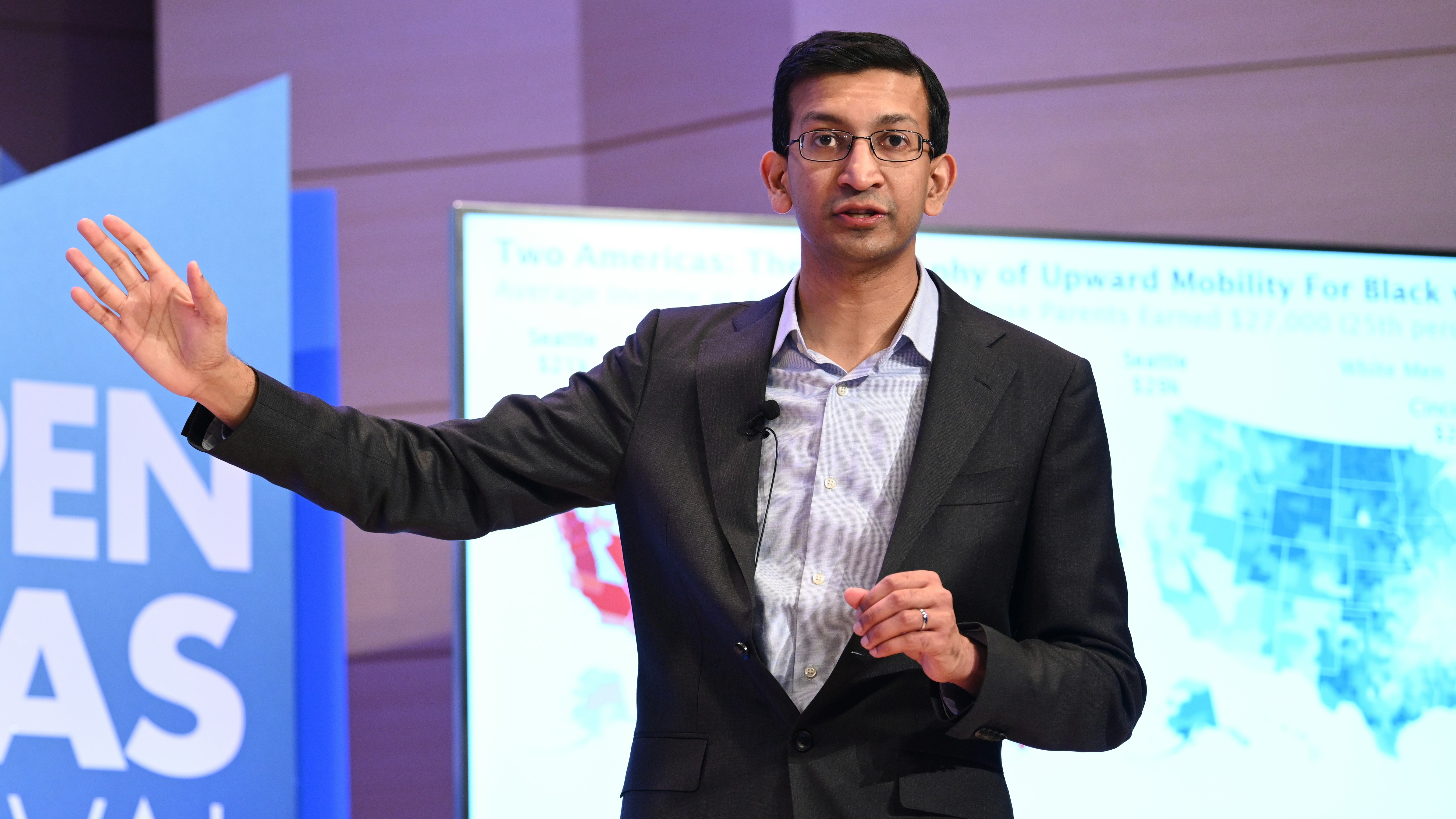

Geography of Opportunity

It’s essentially a 50-50 shot as to whether you’re going to do better than your parents.
Setup
How do we develop scalable policy solutions that will empower families throughout the United States to rise out of poverty and achieve better life outcomes? How we can improve children’s opportunities in communities that currently offer limited prospects for upward income mobility? Award-winning Harvard scholar Raj Chetty, whose research focuses on equality of opportunity, shares remarkable, data-driven insights that can inform policy solutions at every level — and region — of society.
- 2019 Festival
- Economy
- Society
- USA
- Full transcript
Is the American dream alive and well?
The American dream means a lot of things, says economist Raj Chetty, but broadly speaking it signifies equal opportunity for socioeconomic advancement. Chetty was curious if this promise of generational growth holds water, so he looked at the numbers:
Someone born in the 1940s had over a 90 percent chance of earning more than their parents, says Chetty. But that number has plummeted, and today “it’s essentially a 50-50 shot as to whether you’re going to do better than your parents.” Chetty goes on to say that even those 50 percent odds aren’t the whole picture. Some places are doing better than others, and there are clear geographic indicators that determine if the American dream is alive in your neighborhood.
Economic mobility is way more localized than you’d think
When Raj Chetty displays maps of economic mobility around the country, it’s easy to think that whole states or cities are more or less upwardly mobile. Chetty says that isn’t so, and he uses an example from New York City to prove his point:
By zooming into a block-by-block map of economic mobility, Chetty shows that a city like Manhattan, which as a whole seems upwardly economic mobile, can have neighborhoods just a few blocks apart that are on opposite ends of the economic mobility spectrum. Chetty says this phenomenon shows up almost everywhere around the country, and that generalizing whole cities and states as more or less upwardly mobile erases important details.
See for yourself
The later you move, the worse your outcomes
Raj Chetty tracked young people as they moved from areas of less opportunity to areas of greater opportunity in the Seattle metro in order to better understand geography’s relationship to economic mobility. He discovered three critical takeaways:
This excerpt has been lightly edited for clarity
-

Raj Chetty: The first is that where you grow up really seems to matter… If you take a given child and help that child move to a higher opportunity area where we're seeing better outcomes for kids who grew up there from birth, that child ends up doing much better, has significantly better life outcomes, not just in terms of earnings, but a variety of other outcomes like college attendance rates, lower rates of incarceration, and so forth. Second, what really seems to matter is childhood environment rather than where you're living as an adult. We see in this study and in other analyses we've done that helping people move to a different area after they're 23 or so has essentially no impact on their economic outcomes. Third, you see that every extra year of childhood exposure to a better environment leads to better outcomes. So there's kind of a dosage response here. If you spend two years in a better area that yields some benefit. If you spend four years or six years in a better area, you get a cumulatively larger impact.
Chetty says that these findings should have major implications for policy makers as they try to allocate funds and resources to have the greatest impact.
What makes some areas better than others?
The evidence is plain that geography plays a huge role in economic mobility, says Raj Chetty. The question is, why? Chetty points to four main reasons:
Although these aren’t hard and fast rules, Chetty says that lower poverty rates, more stable family structures, greater social capital, and better school quality are all strongly predictive of economic mobility within any given neighborhood.
From research to policy: three pillars
If researchers understand the root causes of unequal economic mobility, says Chetty, they can give concrete advice to policy makers. Chetty has put together a plan to level the playing field of economic mobility, centered around three main pillars:
Take Action
- Reduce segregation
- Place-based investments
- Improve higher education
Reducing economic segregation (helping families move to more advantaged neighborhoods) is a comparatively straightforward solution, says Chetty, but not scalable enough to address the whole problem. To improve communities themselves, Chetty advocates for targeted, place-based investments that stay in communities. And lastly, higher education becomes a critical component of economic mobility that’s both neglected and underutilized.
Learn More
Additional Information
Explore More
Economy


For years, Yale undergraduate students have lined up to take a wildly popular course called Life Worth Living. Bucking the highly competitive tone you might expect at an Ivy L...

Global conflicts and health crises have put into stark relief deeply-ingrained gender roles in society. Yet the past years have also seen record-high numbers of women running...


The world seems to be moving and evolving faster than ever before, and democratic ideals are under threat in many countries around the globe. New York Times columnist and jour...

How is constitutional law being harnessed to address climate change? Ahead of Aspen Ideas: Climate, we caught up with Andrea Rodgers, Senior Attorney at Our Children's Trust,...


History has the power to teach us what to do in the present, but do we actually make good use of that tool? Many events in our recent past might suggest otherwise. American hi...


After millennia of human existence, we’re still figuring out and talking constantly about one of our most fundamental behaviors – sex. Despite the sexual revolution of the 60s...

Of course, Black history shouldn’t just be a month-long nod on our yearly calendar — it is inextricable from American history and fundamental to the very soul of our nation an...


Teenagers and young adults today are dealing with challenges their parents never experienced and couldn’t have prepared for. Nobody has a map and the road to resolution can be...

The unflinching humanity and morality that Martin Luther King, Jr. embodied is part of what makes his legacy so lasting. In addition to his preeminent civil rights work, he sp...

Whether you love setting New Year’s resolutions or ignore them entirely, there’s still a certain mix of nostalgia and excitement over the ending of one year and the possibilit...


Living a happy life isn’t as simple as having a smile on your face all the time. We often think that our negative emotions should be minimized and repressed, but acknowledging...


The human capacity for empathy allows us to communicate, collaborate and understand each other. But we all know empathy isn’t always easy, and we can feel worn down by the eff...


The stories we hear about migrants trying to escape difficult circumstances tend to focus on hardship, conflict, statistics and policy. We rarely get a deep look at any of the...


When Duke divinity school professor Kate Bowler wrote her best-selling memoir, “Everything Happens for a Reason (and Other Lies I’ve Loved),” she was grappling with the conseq...


For adults, the pressure to drink at social engagements, work events, restaurants or almost anywhere outside the home can feel constant. Recent research has found that “no amo...


In today’s world, we tend to switch jobs more frequently than previous generations, and are more likely to have multiple jobs. Side gigs where we express passions or find mean...


Most Americans today would agree that the dream of supporting a family and living a good life on one full time salary is not available to vast numbers of people. Wages have no...


Climate change catastrophes are already happening with increasing regularity, and it’s clear we need to take action. The Biden administration has set a target of zero carbon e...

Finding ways to ground ourselves on a planet too often in turmoil can foster the resilience we need to function at our best. By maintaining close personal ties, learning new s...

Philosophers throughout history have debated what it means to live a good life, and it remains an ongoing and unresolved question. Deep personal relationships, fulfilling work...
















